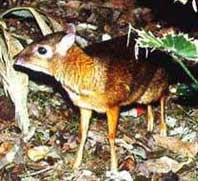Chi-squared in biology: Testing for a dihybrid ratio
You may have noticed we haven't talked about using chi-squared in biology yet. We're going to do that now.
In biology you can use a chi-squared test when you expect to see a certain pattern or ratio of results. For example:
- you expect to see animals using different kinds of habitats equally
- you expect to see a certain ratio of predator to prey
- you expect to see a certain ratio of phenotypes from mating
We'll focus on the last one. If that's what you're also doing in class, what a coincidence!
In that module, we considered two (hypothetical!) genes in mice. T and t coded for normal teeth or vampire fangs, respectively, and F and f coded for smooth or fuzzy fur, respectively.
A dihybrid mouse would have one copy of each of the 4 alleles and would look completely normal: ![]() However, if two such mice mated, they would have offspring that showed the whole range of possible phenotypes: normal (
However, if two such mice mated, they would have offspring that showed the whole range of possible phenotypes: normal ( ![]() ), fanged (
), fanged (![]() ), fuzzy (
), fuzzy (![]() ), and fuzzy and fanged (
), and fuzzy and fanged (![]() ) . Furthermore, these phenotypes should appear in approximately the ratio 9:3:3:1, resulting in a nursery that looks something like this (if 16 babies were born).
) . Furthermore, these phenotypes should appear in approximately the ratio 9:3:3:1, resulting in a nursery that looks something like this (if 16 babies were born).
But, as we discussed in that module, the process of generating new mice is random, so the ratio will not be exact. Now we have the tools to test whether an actual litter approximates the 9:3:3:1 ratio.
If Mr and Mrs Mouse are both heterozygous for both traits (TtFf), then their offspring should follow the 9:3:3:1 ratio. So if they had 160 babies, how many of each type would you expect?

all normal |
|
fanged |
|
fuzzy |
|
fuzzy and fanged |
Mr and Mrs Mouse have 80 normal, 33 fanged, 33 fuzzy, and 14 fuzzy fanged babies. Does this data support the double hybrid model of the data?
| degrees of freedom | Χ2 crit for p-value of 0.05 |
|---|---|
| 1 | 3.84 |
| 2 | 5.99 |
| 3 | 7.81 |
| 4 | 9.49 |
| 5 | 11.07 |
| 6 | 12.59 |
| 7 | 14.07 |
| 8 | 15.51 |
| 9 | 16.92 |
| 10 | 18.31 |
Answer: df=3; Chi-squared statistic = 3.11, which is not bigger than 7.81 (the chi-squared critical value), so the data fit the model -- the ratio of phenotypes supports the double hybrid model of the data.
Copyright University of Maryland, 2007
You may link to this site for educational purposes.
Please do not copy without permission
requests/questions/feedback email: mathbench@umd.edu